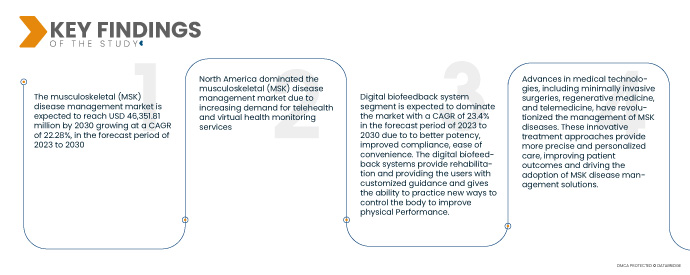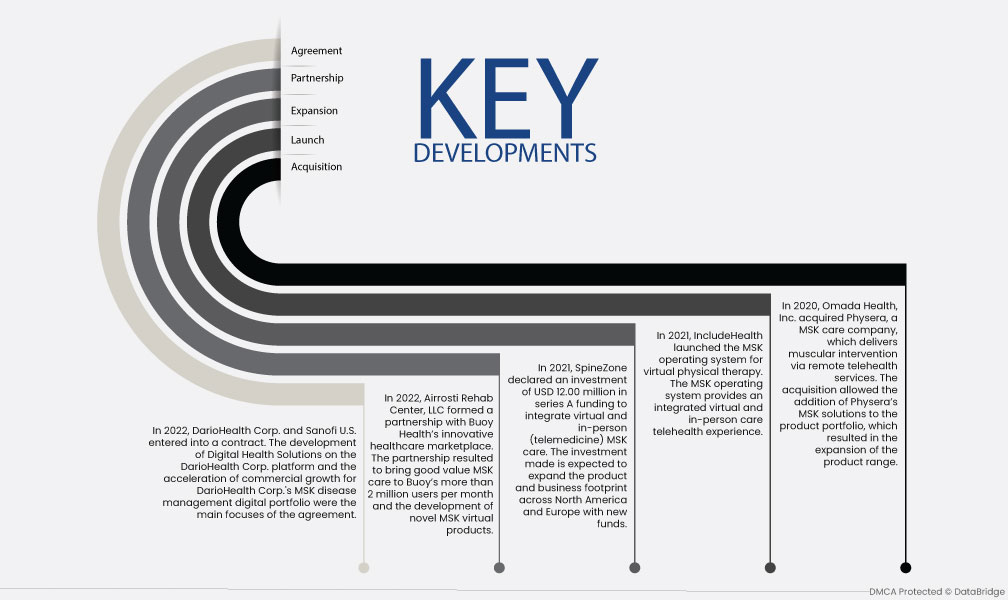The global musculoskeletal (MSK) disease Management market is driven by several factors. Firstly, there is a growing demand for technological advancements in diagnosing MSK diseases, leading to more accurate and efficient diagnoses. Secondly, increased awareness about MSK diseases among the general population has resulted in early detection and timely treatment. Additionally, the rising prevalence of Rheumatoid Arthritis (RA) and the growing number of bone fractures further contribute to the market's growth as they require effective disease management solutions.
Access Full Report @ https://www.databridgemarketresearch.com/reports/global-musculoskeletal-msk-disease-management-market
Data Bridge Market Research analyses that the Musculoskeletal (MSK) Disease Management Market is expected to reach USD 46,351.81 million by 2030 growing at a CAGR of 22.28%, in the forecast period of 2023 to 2030. The rising incidence of musculoskeletal disorders, such as arthritis, osteoporosis, and back pain, is a key driver of the global MSK disease management market. Factors like aging population, sedentary lifestyles, and occupational hazards contribute to the growing burden of MSK diseases, creating a need for effective management solutions.
Key Findings of the Study
Rising healthcare expenditure is expected to drive the market's growth rate
The global Musculoskeletal (MSK) Disease Management market is experiencing growth due to the rising healthcare expenditure worldwide. Factors such as population growth, economic development, and the need for better healthcare infrastructure have led to increased investments in MSK disease management programs. Governments and private entities are recognizing the economic burden of these conditions and are focusing on improving patient outcomes. This increased investment in MSK disease management contributes to the market's growth by providing better resources and care for individuals with MSK diseases.
Report Scope and Market Segmentation
|
Report Metric
|
Details
|
|
Forecast Period
|
2023 to 2030
|
|
Base Year
|
2022
|
|
Historic Years
|
2021 (Customizable to 2015-2020)
|
|
Quantitative Units
|
Revenue in USD Million, Volumes in Units, Pricing in USD
|
|
Segments Covered
|
Type (Digital Biofeedback System, Musculoskeletal-focused Digital Apps, Solutions and Others), Technology (Precision Motion Technology, Computer Vision Technology and Other Technologies), Integration Type (Phone, Tablet, Computer and Others), Modality (Virtual Therapy, In-Person Therapy, Customized/Personalized Therapy and Others), Application (Pre-Surgery Applications and Post-Surgery Applications), Patient Population (Pediatrics, Adults and Geriatrics), End User (Hospitals and Clinics, Nursing Homes, Health Centers, Rehabilitation Centres, Virtual/Home Health Care Settings and Others)
|
|
Countries Covered
|
U.S., Canada and Mexico in North America, Germany, France, U.K., Netherlands, Switzerland, Belgium, Russia, Italy, Spain, Turkey, Rest of Europe in Europe, China, Japan, India, South Korea, Singapore, Malaysia, Australia, Thailand, Indonesia, Philippines, Rest of Asia-Pacific (APAC) in the Asia-Pacific (APAC), Saudi Arabia, U.A.E, South Africa, Egypt, Israel, Rest of Middle East and Africa (MEA) as a part of Middle East and Africa (MEA), Brazil, Argentina and Rest of South America as part of South America.
|
|
Market Players Covered
|
RecoveryOne (U.S.), Kiio (U.S.), Omada Health Inc. (U.S.), DarioHealth Corp. (U.S.), IncludeHealth (U.S.), kaia health (Germany), IMC. (U.S.), Wellness Coaches USA, LLC (U.S.), Sparta Science (U.S.)Movement RX (U.S.), Phzio (U.S.), Airrosti Rehab Center, LLC (U.S.), SimpleTherapy, Inc. (U.S.), Hinge Health, Inc. (U.S.)Sword Health, Inc. (U.S.), SPRITE HEALTH (U.S.), Limber Health, Inc. (U.S.) among others
|
|
Data Points Covered in the Report
|
In addition to the insights on market scenarios such as market value, growth rate, segmentation, geographical coverage, and major players, the market reports curated by the Data Bridge Market Research also include depth expert analysis, patient epidemiology, pipeline analysis, pricing analysis, and regulatory framework.
|
Segment Analysis:
The musculoskeletal (MSK) disease management market is segmented on the basis of type, technology, integration type, modality, application, patient population and end user
- On the basis of type, the market is segmented into digital biofeedback system, musculoskeletal-focused digital apps (MDAs), solutions, and others. In 2023, the digital biofeedback system segment is expected to dominate the market with a CAGR of 23.4% in the forecast period of 2023 to 2030 due to to better potency, improved compliance, ease of convenience. The digital biofeedback systems provide rehabilitation and providing the users with customized guidance and gives the ability to practice new ways to control the body to improve physical performance.
- On the basis of technology, the market is segmented into precision motion technology, computer vision technology, and other technologies. In 2023, the precision motion technology segment is expected to dominate the market with a market share of 59.45% in the forecast period of 2023 to 2030 due to manufacturing, robotics, medical devices, and aerospace, where precise positioning, control, and accuracy are essential.
In 2023, the precision motion technology segment is expected to dominate the technology segment of the market
In 2023, the precision motion technology segment is expected to dominate the market owing to the use of high-precision components, sensors, and control systems to achieve accurate motion control for enhanced performance and productivity with a market share of 59.45% in the forecast period of 2023 to 2030.
- On the basis of integration type, the market is segmented into phone, tablet, computers, and others. In 2023, the phone segment is expected to dominate the market with a CAGR of 23.4% in the forecast period of 2023 to 2030 due to specific features or applications in smartphones to enhance functionality or provide additional services.
- On the basis of modality, the market is segmented into virtual therapy, in-person therapy, customized/personalized therapy, and others. In 2023, the virtual therapy segment is expected to dominate the market with a CAGR of 23.5% in the forecast period of 2023 to 2030 due to improvements in pain management, gait, physical function, rise in patient population, and improved patient outcomes, which are expected to drive segment growth
- On the basis of application, the market is segmented into pre-surgery applications, post-surgery applications, and others. In 2023, the pre-surgery application segment is expected to dominate the market with a market share of 54.02%. In the forecast period of 2023 to 2030 due to medical imaging scans, such as MRI or CT scans. These applications provide tools for visualizing and measuring anatomical structures, identifying potential surgical targets, and simulating surgical procedures.
- On the basis of the patient population, the market is segmented into paediatrics, adults, and geriatrics. In 2023, the pediatrics segment is expected to dominate the market with a CAGR of 23.2% in the forecast period of 2023 to 2030 due to a wide range of medical specialties, including preventive care, immunizations, developmental assessment, and management of chronic conditions specific to this age group.
In 2023, the pediatrics segment is expected to dominate the patient population segment of the market
In 2023, the pediatrics segment is expected to dominate the patient population segment of the market owing to the wide range of medical specialties, including preventive care, immunizations, developmental assessments, treatment of common childhood illnesses, and management of chronic conditions specific to this age group with a CAGR of 23.2% in the forecast period of 2023 to 2030
- On the basis of end-user, the market is segmented into hospitals and clinics, nursing homes, health centers, rehabilitation centers, virtual/home healthcare settings, and others. In 2023, the hospitals and clinics segment is expected to dominate the market with a CAGR of 23.7% in the forecast period of 2023 to 2030 due to emergency care, surgeries, diagnostics, inpatient care, outpatient care, and specialized treatments. They are equipped with medical professionals, advanced technologies, and various departments to cater to diverse healthcare needs.
Major Players
Data Bridge Market Research recognizes the following companies as the major musculoskeletal (MSK) disease management market players in musculoskeletal (MSK) disease management market are RecoveryOne (U.S.), Kiio (U.S.), Omada Health Inc. (U.S.), DarioHealth Corp. (U.S.), IncludeHealth (U.S.), kaia health (Germany), IMC. (U.S.), Wellness Coaches USA, LLC (U.S.), Sparta Science (U.S.)Movement RX (U.S.)
Market Development
- In 2022, DarioHealth Corp. and Sanofi U.S. entered into a contract. The development of Digital Health Solutions on the DarioHealth Corp. platform and the acceleration of commercial growth for DarioHealth Corp.'s MSK disease management digital portfolio were the main focuses of the agreement.
- In 2022, Airrosti Rehab Center, LLC formed a partnership with Buoy Health’s innovative healthcare marketplace. The partnership resulted to bring good value MSK care to Buoy’s more than 2 million users per month and the development of novel MSK virtual products.
- In 2021, SpineZone declared an investment of USD 12.00 million in series A funding to integrate virtual and in-person (telemedicine) MSK care. The investment made is expected to expand the product and business footprint across North America and Europe with new funds.
- In 2021, IncludeHealth launched the MSK operating system for virtual physical therapy. The MSK operating system provides an integrated virtual and in-person care telehealth experience.
- In 2020, Omada Health, Inc. acquired Physera, a MSK care company, which delivers muscular intervention via remote telehealth services. The acquisition allowed the addition of Physera’s MSK solutions to the product portfolio, which resulted in the expansion of the product range.
Regional Analysis
Geographically, the countries covered in the musculoskeletal (MSK) disease management market report are U.S., Canada and Mexico in North America, Germany, France, U.K., Netherlands, Switzerland, Belgium, Russia, Italy, Spain, Turkey, Rest of Europe in Europe, China, Japan, India, South Korea, Singapore, Malaysia, Australia, Thailand, Indonesia, Philippines, Rest of Asia-Pacific (APAC) in the Asia-Pacific (APAC), Saudi Arabia, U.A.E, South Africa, Egypt, Israel, Rest of Middle East and Africa (MEA) as a part of Middle East and Africa (MEA), Brazil, Argentina and Rest of South America as part of South America.
As per Data Bridge Market Research analysis:
North America is expected to dominate the region in musculoskeletal (MSK) disease management market during the forecast period 2023-2030
North America is projected to dominate the global musculoskeletal (MSK) disease management market due to several factors. The region has a strong focus on research and development, driving technological advancements in MSK disease management. The increasing demand for telehealth and virtual health monitoring services further contributes to market growth. Additionally, North America boasts a well-developed healthcare infrastructure, which enables efficient delivery of MSK disease management solutions, enhancing patient outcomes and driving market dominance in the region.
For more detailed information about the musculoskeletal (MSK) disease management market report, click here – https://www.databridgemarketresearch.com/reports/global-musculoskeletal-msk-disease-management-market












